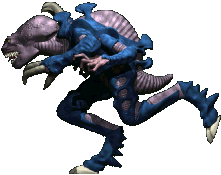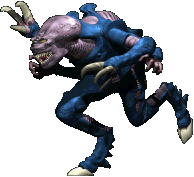Genestealers
 Originally introduced in one of the first Games Workshop books, Rogue Trader, Genestealers were simply considered alien entities in the Warhammer 40,000 universe. They were initially considered a distinct race, separate from the Tyranid. The original background texts point out Genestealers as a species originating from a the moons of a planet called Ymgarl, where these creatures thrived. They are asexual in the sense that they do not mate with others of their race. Instead, they must use other species in order to
propagate. In a very basic description, a Genestealer will attack and implant its own genetic material into its prisoner via an extendable
ovipositor. After which, the egg that is deposited in the unfortunate victim matures quickly and then bursts from within its parent carrier to give birth to a new Genestealer. When these eggs are deposited in other species, such as humans, the new Genestealer hybrid may take on some of the characteristics of its parent host as well, and continue to do so in successive generations. However, on it's own native planet, the Genestealer
population thrived on exploiting creatures called Csiths, also natives to the moons of Ymgarl; curiously, however, the newborns were developed into full Genestealers, rather than some Hybrid.
Originally introduced in one of the first Games Workshop books, Rogue Trader, Genestealers were simply considered alien entities in the Warhammer 40,000 universe. They were initially considered a distinct race, separate from the Tyranid. The original background texts point out Genestealers as a species originating from a the moons of a planet called Ymgarl, where these creatures thrived. They are asexual in the sense that they do not mate with others of their race. Instead, they must use other species in order to
propagate. In a very basic description, a Genestealer will attack and implant its own genetic material into its prisoner via an extendable
ovipositor. After which, the egg that is deposited in the unfortunate victim matures quickly and then bursts from within its parent carrier to give birth to a new Genestealer. When these eggs are deposited in other species, such as humans, the new Genestealer hybrid may take on some of the characteristics of its parent host as well, and continue to do so in successive generations. However, on it's own native planet, the Genestealer
population thrived on exploiting creatures called Csiths, also natives to the moons of Ymgarl; curiously, however, the newborns were developed into full Genestealers, rather than some Hybrid.
In this case, Genestealers were simply presented as a race that allowed some unique interruption into a game, when Game Masters were still called for. There was no such idea that there would be an army list for Genestealers in any way. They were merely something to add an extra facet to a game. When used, the Genestealers had the chance of depositing an egg in it's unfortunate victim, and then the player's character would "explode" into a new baby Genestealer or Hybrid on certain die rolls. After three kills, the baby would then grow to a fully matured Genestealer or Hybrid, and continue it's reproductive rampage! From another standpoint, hybrids were not necessarily "evil" in the way that they are portrayed currently. Instead, there were chances where Hybrids could possibly help humans as well. It was all up to the decision of the Game Master! This introduction of Genestealer Hybrids as a neutral or rogue character (terms most often used in role-playing games), was a very different idea than what it has become.
 By the time Genestealers were added to Space Hulk, they were then presented as a more disturbing alien menace beginning to infest the Imperium. Space Hulk was a game offered by Games Workshop in transition between GW's Rogue Trader / Compendium / Compilation rulesets and the newly rendered Warhammer 40k 2nd Edition. While Space Hulk simply hinted at the Genestealer menace, parallel production of the original Warhammer 40K game was developing the Genestealer phenomenon into a full army list, the Genestealer Cult, which would introduce Genestealer Hybrids, Zoats, Brood Brothers, Magus, and Patriarchs to name a few (army lists available in old White Dwarf publications and compendiums, never an officially bound codex). With this in mind it was an ingenious development to create additional rules (which sold miniatures) for use in Space Hulk, with the introduction of the Space Hulk supplement, "Genestealer". For those people who were not familiar with Warhammer 40K, this supplement lightly introduced Genestealer Cults and Genestealer Hybrids, adding an extra element into the game for a new, refreshing perspective. With the introduction of Hybrids, psychic combat and weaponry was also introduced into Space Hulk to augment the otherwise uninteresting arsenal available to the Genestealer player.
By the time Genestealers were added to Space Hulk, they were then presented as a more disturbing alien menace beginning to infest the Imperium. Space Hulk was a game offered by Games Workshop in transition between GW's Rogue Trader / Compendium / Compilation rulesets and the newly rendered Warhammer 40k 2nd Edition. While Space Hulk simply hinted at the Genestealer menace, parallel production of the original Warhammer 40K game was developing the Genestealer phenomenon into a full army list, the Genestealer Cult, which would introduce Genestealer Hybrids, Zoats, Brood Brothers, Magus, and Patriarchs to name a few (army lists available in old White Dwarf publications and compendiums, never an officially bound codex). With this in mind it was an ingenious development to create additional rules (which sold miniatures) for use in Space Hulk, with the introduction of the Space Hulk supplement, "Genestealer". For those people who were not familiar with Warhammer 40K, this supplement lightly introduced Genestealer Cults and Genestealer Hybrids, adding an extra element into the game for a new, refreshing perspective. With the introduction of Hybrids, psychic combat and weaponry was also introduced into Space Hulk to augment the otherwise uninteresting arsenal available to the Genestealer player.
Quickly, however, the short-lived Genestealer Cult army was eclipsed by Codex:Tyranids, or rather, the first White Dwarf to spotlight this army. Once 2nd Edition Warhammer 40K was well into production, the Codex:Tyranids was introduced and Genestealers and its cult were suddenly absorbed into this army heading. The official Genestealer Cult was no more. Genestealers in the third edition of Warhammer 40K are not the centerpiece of troops that they once were, and Genestealer Hybrids are defunct as army pieces. References to Genestealer Cults now are simply made with the notion that Genestealer Cults are developed to undermine local governments and signal a psychic beacon to attract the Tyranid race; the actual cult is no longer available in official army lists. Still there are a few gamers out there who remain faithful to the Genestealer Cult army lists, and these can be found on the net in various forms and interpretations.
 Deathwing did little to introduce anything new for the Genestealer player, except a story in the booklet that outlined the fact that there were Genestealer cults in the "Space Hulk world". The Genestealer supplement would finally introduce the cult as possible pieces into the game, notably the Hybrids, Magus and Patriarch. Genestealer's main contribution to Space Hulk was the revised psychic combat rules for the Genestealer player. Without the use of psychic combat, Hybrids were often ill-matched against Terminators, as they were sometimes armed with weak weapons; the absense of psychic powers in random miniatures greatly diminished their powers against Terminators.
Deathwing did little to introduce anything new for the Genestealer player, except a story in the booklet that outlined the fact that there were Genestealer cults in the "Space Hulk world". The Genestealer supplement would finally introduce the cult as possible pieces into the game, notably the Hybrids, Magus and Patriarch. Genestealer's main contribution to Space Hulk was the revised psychic combat rules for the Genestealer player. Without the use of psychic combat, Hybrids were often ill-matched against Terminators, as they were sometimes armed with weak weapons; the absense of psychic powers in random miniatures greatly diminished their powers against Terminators.
With the increasing popularity of the Tyranid army and the tempting line of possible models that could be exploited and used in Space Hulk, many Space Hulk fans have gone out of their way to make "House Rules" to introduce more interesting miniatures into the Genestealer horde, such as Zoats, Termagants, and Tyranids.
Advanced Space Crusade and Tyranid Attack were similar to Space Hulk, but played in a different manner based on using more of the Tyranid army models, and a full range of other races as well besides Space Marines, such as Orks, Chaos Marines, and even Dreadnoughts. These games never quite reached the amount of popularity that Space Hulk had achieved. However, it is easy to adapt either sets of rules to either playing boards or even combine them! Currently, Genestealer cults have again seen a little light, and are featured as an official list in the Citadel Journals #40 and #41. However, from the 2nd Edition Space Hulk game, the hybrids are no where to be seen.